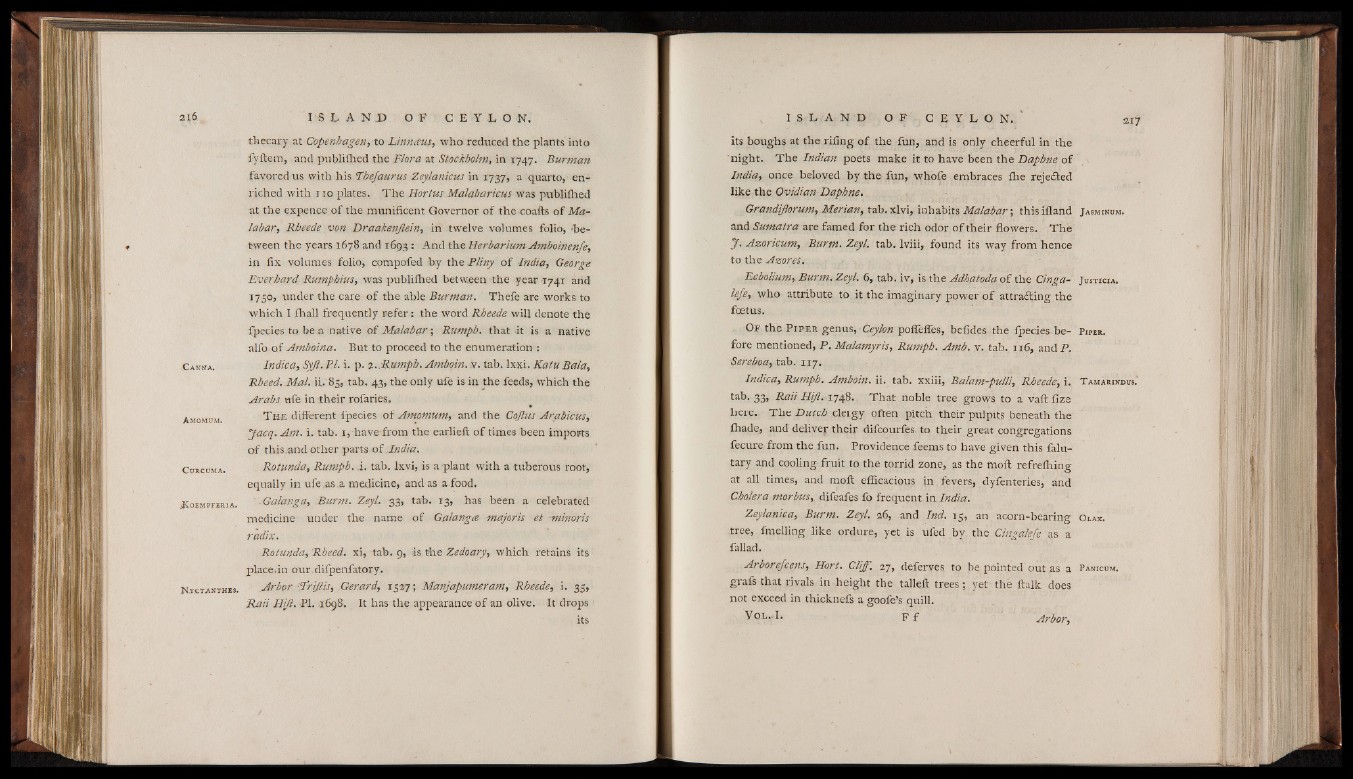
C a n n a .
A m o m ü m .
C u r c u m a .
_<JCoEMPFERlA.
N,y.CTANTHES.
thecary at Copenhagen, to Linnaus, who reduced the plants into
fyftem, and publiihed the Flora at Stockholm, in 1747. Burman
favored us with his Tbefaurus Zeylanicus in 1737, a quarto, enriched
with n o plates. The Hortus Malabaricus was publiihed
at the expence of the munificent Governor of thecoafts o f Malabar,
Rbeede von Draakenßein, in twelve volumes folio, ‘between
the years 1678 and 1693 : And the Herbarium Amboinenfe,
in fix volumes folio, compofed by the Pliny of India, George
Everbard Rumphius, was publiihed between the year 1741 and
1750, tinder the care o f the able Burman. Thefe are works to
which I fhall frequently refer: the word Rbeede will denote the
fpecies to be a native of Malabar; Rumph. that it is a native
alfo of Amboina. But to proceed to the enumeration ;
Indica, Syß. PI. i. p. 2. Rumph. Amboin. -v. tab. Ixxi. Katu Bala,
Rbeed, Mai. ii. 85, tab. 43, the only ufe is in the feeds, which the
Arabs ufe in their rofaries,
T h-e different fpecies o f Amomum, and the Cofius Arabicus,
Jacq. Am. i. tab. 1, have from the earlieit o f times been imports
o f this,and other parts o f .India.
Rotunda, Rumph. i. tab. Ixvi, is a plant with a tuberous root,
equally in ufe,as.a medicine, and as a food.
.Galanga, Burm. ZeyL 33, tab. 13, has been a celebrated
medicine under the name o f Galanga majoris et -minoris
radix.
Rotunda, Rhecd. xi, tab. 9, is. the Zedoary, which retains its
place,in our difpenfatory.
Arbor ptrißis, Gerard, 1527; Manjapumeram, Rbeede, i. 33,
Raii Hiß. Bl. 1698. It has the appearance o f an olive. It drops
its
its boughs at the riling of the fun, and is only cheerful in the
night. The Indian poets make it to have been the Daphne of
India, once beloved by the fun, whole embraces ihe rejected
like the Ovidian Daphne.
Grandiflorum, Merian, tab. xlvi, inhabits Malabar; thisiiland J asmihom.
and Sumatra are famed for the rich odor of their flowers. The
J . Azoricum, Burm. Zeyl. tab. lviii, found its way from hence
to the Azores, .
Ecbolium, Burm, Zeyl. 6 , tab. iv, is the Adhatoda of the Cinga- J u s t i c i a .
lefe,. who attribute to it the imaginary power o f attrailing the
foetus.
Or the P ip e r genus, - Ceylon poflefles, belides the fpecies be- P i p e r .
fore mentioned, P . Malamyris, Rumph. Amb. v. tab. 1Y6, and P.
Sereboa, tab. 117.
Indica, Rumph. Amboin. ii. tab. xxiii, Balam-pulli, Rbeede, i. T a m a r i n d u s .
tab. 33, Raii Hiß. 1748. That noble tree grows to a vaft fize
here. The Dutch cleigy often pitch their pulpits beneath the
ihade, and deliver their difcourfes to their great congregations
fecure from the fun. Providence feems to have given this falu-
tary and cooling fruit to the torrid zone, as the moft refreihing
at all times, and moil efficacious in fevers, dyfenteries, and
Cholera morbus, difeafes io frequent in India.
Zeylanica, Burm. Zeyl. 26, and Ind. 15, an acorn-bearing O la x .
tree, fmelling like ordure, yet is ufed by the Cingalefe as a
fallad.
Arborefcens, Hort. Cliff. 27, deierves to be pointed out as a Panicum,
grafs that rivals in height the talleil trees; yet the italk does
not exceed in thicknefs a goofe’s quill.
V o l.. I. F f ‘ Arbor,